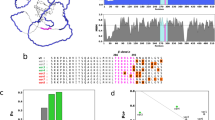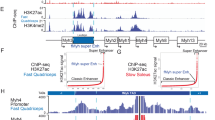Abstract
Chromosomal translocations involving the human CBFB gene, which codes for the non-DNA binding subunit of CBF (CBFβ), are associated with a large percentage of human leukemias. The translocation inv(16) that disrupts the CBFB gene produces a chimeric protein composed of the heterodimerization domain of CBFβ fused to the C-terminal coiled-coil domain from smooth muscle myosin heavy chain (CBFβ-SMMHC). Isothermal titration calorimetry results show that this fusion protein binds the Runt domain from Runx1 (CBFα) with higher affinity than the native CBFβ protein. NMR studies identify interactions in the CBFβ portion of the molecule, as well as the SMMHC coiled-coil domain. This higher affinity provides an explanation for the dominant negative phenotype associated with a knock-in of the CBFB-MYH11 gene and also helps to provide a rationale for the leukemia-associated dysregulation of hematopoietic development that this protein causes.
This is a preview of subscription content, access via your institution
Access options
Subscribe to this journal
Receive 12 print issues and online access
$189.00 per year
only $15.75 per issue
Buy this article
- Purchase on Springer Link
- Instant access to full article PDF
Prices may be subject to local taxes which are calculated during checkout





Similar content being viewed by others

References
Ogawa, E. et al. Virology 194, 314–331 (1993).
Wang, S. et al. Mol. Cell. Biol. 13, 3324–3339 (1993).
Liu, P. et al. Science 261, 1041–1044 (1993).
Bae, S.C. et al. Gene 159, 245–248 (1995).
Levanon, D. et al. Genomics 23, 425–432 (1994).
Ogawa, E. et al. Proc. Natl. Acad. Sci. USA 90, 6859–6863 (1993).
Wang, Q. et al. Proc. Natl. Acad. Sci. USA 93, 3444–3449 (1996).
Wang, Q. et al. Cell 87, 697–708 (1996).
Okuda, T., van Deursen, J., Hiebert, S.W., Grosveld, G. & Downing, J.R. Cell 84, 321–330 (1996).
Sasaki, K. et al. Proc. Natl. Acad. Sci. USA 93, 12359–12363.
Look, A.T. Science 278, 1059–1064 (1997).
Castilla, L.H. et al. Cell 87, 687–696 (1996).
Yergeau, D.A. et al. Nature Genet. 15, 303–306 (1997).
Okuda, T. et al. Blood 91, 3134–3143 (1998).
Liu, P. et al. Science 261, 1041–1044 (1993).
Castilla, L.H. et al. Cell 87, 687–696 (1996).
Castilla, L.H. et al. Nature Genet. 23, 144–146 (1999).
Kogan, S.C. et al. Proc. Natl. Acad. Sci. USA 95, 11863–11868 (1998).
Adya, N., Stacy, T., Speck, N.A., & Liu, P.P. Mol. Cell. Biol. 18, 7432–7443 (1998).
Lutterbach, B., Hou, Y., Durst, K.L. & Hiebert, S.W. Proc. Natl. Acad. Sci. USA 96, 12822–12827 (1999).
Liu, P.P., Hajra, A., Wijmenga, C. & Collins, F.S. Blood 85, 2289–2302 (1995).
Tang, Y.-Y. et al. FEBS Lett. 470, 167–172 (2000).
Perez-Alvarado, G.C., Munnerlyn, A., Dyson, H.J., Grosschedl, R. & Wright, P.E. FEBS Lett. 470, 167–172 (2000).
Berardi, M. et al. Struct. Fold. Des. 7, 1247–1256 (1999).
Bains, G. & Freire, E. Anal. Biochem. 192, 203–206 (1991).
Yang, D. & Kay, L.E. J. Biomol. NMR 13, 3–10 (1999).
Takahashi, H., Nakanishi, T., Kami, K., Arata, Y. & Shimada, I. Nature Struct. Biol. 7, 220–223 (2000).
Huang, X., Peng, J.W., Speck, N.A. & Bushweller, J.H. Nature Struct. Biol. 6, 624–627 (1999).
Goger, M. et al. Nature Struct. Biol. 6, 620–623 (1999).
Bravo, J., Li, Z., Speck,N.A. & Warren, A.J. Nature Struct. Biol. 8, 371–377 (2001).
Tahirov, T.H. et al. Cell 104, 755–767 (2001).
Tang, Y.Y. et al. J. Biol. Chem. 275, 39579–39588 (2000).
Acknowledgements
This work was supported by grants from the United States Public Health Service (NIH) to J.H.B. The National High Magnetic Field Laboratory at Florida State University is supported by NSF and the State of Florida. NMRFAM is supported by the NIH Biomedical Technology Program and NIH Shared Instrumentation Program. R.L.B. and N.A.S. are supported by grants from the United States Public Health Service (NIH). M.K. is supported by a fellowship from the Damon Runyon Cancer Research Foundation.
Author information
Authors and Affiliations
Corresponding author
Ethics declarations
Competing interests
The authors declare no competing financial interests.
Rights and permissions
About this article
Cite this article
Lukasik, S., Zhang, L., Corpora, T. et al. Altered affinity of CBFβ-SMMHC for Runx1 explains its role in leukemogenesis. Nat Struct Mol Biol 9, 674–679 (2002). https://doi.org/10.1038/nsb831
Received:
Accepted:
Published:
Issue Date:
DOI: https://doi.org/10.1038/nsb831
This article is cited by
-
Advances in targeting ‘undruggable’ transcription factors with small molecules
Nature Reviews Drug Discovery (2021)
-
CBFβ-MYH11 interferes with megakaryocyte differentiation via modulating a gene program that includes GATA2 and KLF1
Blood Cancer Journal (2019)
-
Runx1 is required for hematopoietic defects and leukemogenesis in Cbfb-MYH11 knock-in mice
Leukemia (2015)
-
Molecular pathogenesis of core binding factor leukemia: current knowledge and future prospects
International Journal of Hematology (2011)


